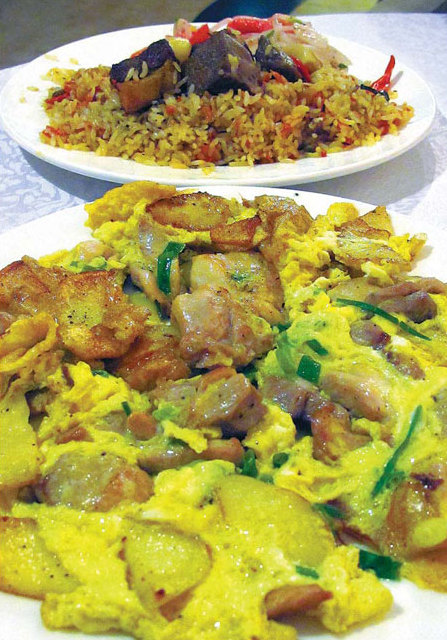Rice, Kazak style
Updated: 2013-04-07 07:45
By Mike Peters (China Daily)
|
|||||||||||
|
Fried chicken is sauteed with potatoes and egg for an omeletlike entree. Astana's popular pilaf is in back. Photos by Mike Peters / China Daily |
A plate of pilaf is just the start of a homestyle Central Asian feast, Mike Peters discovers.
Even in China, it's a little surprising to hear so much fuss about a restaurant's rice dish. But ask anyone who's been to Astana, which lays claim to being Beijing's first Kazak restaurant, and you'll almost certainly get a misty-eyed rave about the pilaf.
Also known as "plov" and "pilau", this hearty rice dish is a staple in most of Central Asia. There are Russian versions, Uzbek versions, Chinese versions from the Xinjiang Uygur autonomous region and a San Francisco version courtesy of Rice-a-Roni.
Astana's robust version has strong hints of cumin and chili and a satisfying amount of tender lamb chunks on top of a platter that goes for an eminently reasonable 35 yuan ($5.60).
Other starchy offerings include fried Kazak bread and the more exotic hychina flatbread, a yummy curiosity soaked in melted cheese.
We'd been advised to try the dumplings as a starter, and found the succulent steamed packages of meat and pumpkin nearly large enough to make a meal on their own. There are meat-only and vegetable-only versions as well.
As befits its location in the capital's hopping Russian district around Ritan Park - and Kazakhstan's real-life proximity to Russia - the restaurant is influenced by the neighborhood.
In fact, Astana plays that like a trump suit, deftly serving up steaming bowls of borscht - the beet soup staple of the Russian heartland - as winsome as any in town.
You get a big portion redolent with dill and nice bits of meat, a hearty warm-up for the meal to come even after Beijing's lingering chill finally dissipates.
We also sampled a Kazak clear soup, in which a single sheet of noodle floated with tender mutton. It was a bit salty for our taste, but that inspired us to drink more of the excellent Russian beer on offer, so we were forgiving on that score.
The restaurant has a full bar, and nearby tables clinked with toasts fueled from all sorts of exotic-looking bottles.
For our entree with the pilaf, we opted for one of the fried-chicken options. This was not the battered and deep fried style of the American South. Colonel Sanders might not recognize it at all.
In this home-style dish, the chicken is sliced into bite-size pieces and sauteed with potatoes and eggs. The result is a borderline omelet, fragrant with garlic and deliciously filling.
We also sampled a tasty plate of lamb chops served with roasted potatoes and fresh onion slices. A small "spicy carrot salad" didn't have much kick, but the simple strands of marinated vegetable added crunch and color to the meal.
The restaurant's ambience is very pleasant, with comfortable booth seating and background sound that varies from our Friday night troubador singing in English to Fashion TV and Russian pop soundtracks. Servers are kitted out in charming ethnic garb and unflagging smiles, a vibe that is inevitably contagious.
Contact the writer at michaelpeters@chinadaily.com.cn.
Today's Top News
Police continue manhunt for 2nd bombing suspect
H7N9 flu transmission studied
8% growth predicted for Q2
Nuke reactor gets foreign contract
First couple on Time's list of most influential
'Green' awareness levels drop in Beijing
Palace Museum spruces up
Trading channels 'need to broaden'
Hot Topics
Lunar probe , China growth forecasts, Emission rules get tougher, China seen through 'colored lens', International board,
Editor's Picks

|

|

|

|

|

|






